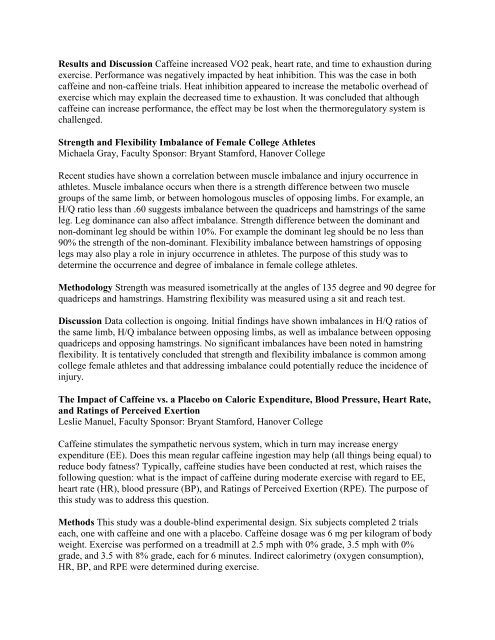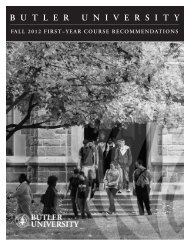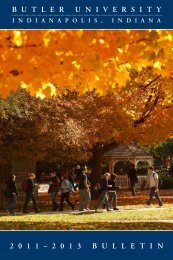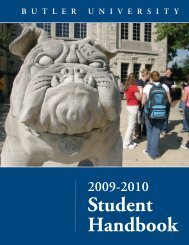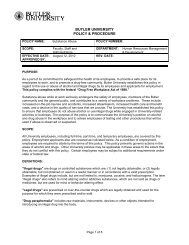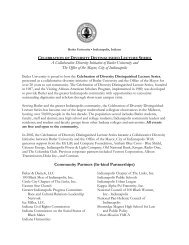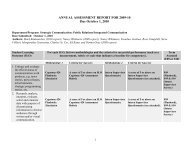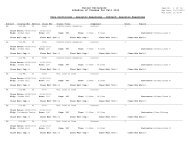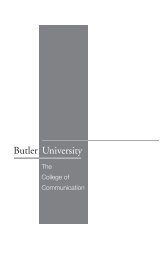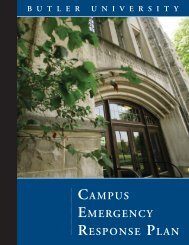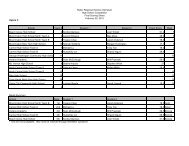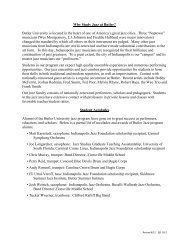Anthropology - Butler University
Anthropology - Butler University
Anthropology - Butler University
You also want an ePaper? Increase the reach of your titles
YUMPU automatically turns print PDFs into web optimized ePapers that Google loves.
Results and Discussion Caffeine increased VO2 peak, heart rate, and time to exhaustion during<br />
exercise. Performance was negatively impacted by heat inhibition. This was the case in both<br />
caffeine and non-caffeine trials. Heat inhibition appeared to increase the metabolic overhead of<br />
exercise which may explain the decreased time to exhaustion. It was concluded that although<br />
caffeine can increase performance, the effect may be lost when the thermoregulatory system is<br />
challenged.<br />
Strength and Flexibility Imbalance of Female College Athletes<br />
Michaela Gray, Faculty Sponsor: Bryant Stamford, Hanover College<br />
Recent studies have shown a correlation between muscle imbalance and injury occurrence in<br />
athletes. Muscle imbalance occurs when there is a strength difference between two muscle<br />
groups of the same limb, or between homologous muscles of opposing limbs. For example, an<br />
H/Q ratio less than .60 suggests imbalance between the quadriceps and hamstrings of the same<br />
leg. Leg dominance can also affect imbalance. Strength difference between the dominant and<br />
non-dominant leg should be within 10%. For example the dominant leg should be no less than<br />
90% the strength of the non-dominant. Flexibility imbalance between hamstrings of opposing<br />
legs may also play a role in injury occurrence in athletes. The purpose of this study was to<br />
determine the occurrence and degree of imbalance in female college athletes.<br />
Methodology Strength was measured isometrically at the angles of 135 degree and 90 degree for<br />
quadriceps and hamstrings. Hamstring flexibility was measured using a sit and reach test.<br />
Discussion Data collection is ongoing. Initial findings have shown imbalances in H/Q ratios of<br />
the same limb, H/Q imbalance between opposing limbs, as well as imbalance between opposing<br />
quadriceps and opposing hamstrings. No significant imbalances have been noted in hamstring<br />
flexibility. It is tentatively concluded that strength and flexibility imbalance is common among<br />
college female athletes and that addressing imbalance could potentially reduce the incidence of<br />
injury.<br />
The Impact of Caffeine vs. a Placebo on Caloric Expenditure, Blood Pressure, Heart Rate,<br />
and Ratings of Perceived Exertion<br />
Leslie Manuel, Faculty Sponsor: Bryant Stamford, Hanover College<br />
Caffeine stimulates the sympathetic nervous system, which in turn may increase energy<br />
expenditure (EE). Does this mean regular caffeine ingestion may help (all things being equal) to<br />
reduce body fatness? Typically, caffeine studies have been conducted at rest, which raises the<br />
following question: what is the impact of caffeine during moderate exercise with regard to EE,<br />
heart rate (HR), blood pressure (BP), and Ratings of Perceived Exertion (RPE). The purpose of<br />
this study was to address this question.<br />
Methods This study was a double-blind experimental design. Six subjects completed 2 trials<br />
each, one with caffeine and one with a placebo. Caffeine dosage was 6 mg per kilogram of body<br />
weight. Exercise was performed on a treadmill at 2.5 mph with 0% grade, 3.5 mph with 0%<br />
grade, and 3.5 with 8% grade, each for 6 minutes. Indirect calorimetry (oxygen consumption),<br />
HR, BP, and RPE were determined during exercise.


